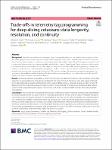Trade-offs in telemetry tag programming for deep-diving cetaceans: data longevity, resolution, and continuity
| dc.contributor.author | Cioffi, WR | |
| dc.contributor.author | Quick, NJ | |
| dc.contributor.author | Swaim, ZT | |
| dc.contributor.author | Foley, HJ | |
| dc.contributor.author | Waples, DM | |
| dc.contributor.author | Webster, DL | |
| dc.contributor.author | Baird, RW | |
| dc.contributor.author | Southall, BL | |
| dc.contributor.author | Nowacek, DP | |
| dc.contributor.author | Read, AJ | |
| dc.date.accessioned | 2023-10-17T11:04:05Z | |
| dc.date.available | 2023-10-17T11:04:05Z | |
| dc.date.issued | 2023-05-29 | |
| dc.identifier.issn | 2050-3385 | |
| dc.identifier.issn | 2050-3385 | |
| dc.identifier.other | 23 | |
| dc.identifier.uri | https://pearl.plymouth.ac.uk/handle/10026.1/21450 | |
| dc.description.abstract |
Background Animal-borne telemetry instruments (tags) have greatly advanced our understanding of species that are challenging to observe. Recently, non-recoverable instruments attached to cetaceans have increased in use, but these devices have limitations in data transmission bandwidth. We analyze trade-offs in the longevity, resolution, and continuity of data records from non-recoverable satellite-linked tags on deep-diving Ziphius cavirostris in the context of a behavioral response study of acute noise exposure. We present one data collection programming scheme that balances resolution and continuity against longevity to address specific questions about the behavioral responses of animals to noise exposure in experimental contexts. We compare outputs between two programming regimes on a commercially available satellite-linked tag: (1) dive behavior summary defined by conductivity thresholds and (2) depth time-series at various temporal resolutions. Results We found that time-series data vary from the more precisely defined dives from a dive summary record data stream by an acceptable error range for our application. We determined a 5-min time-series data stream collected for 14 days balanced resolution with longevity, achieving complete or nearly complete diving records in 6 out of 8 deployments. We increased our data message reception rate several fold by employing a boat based data capture system. Finally, a tag deployed in a group concurrently with a high-resolution depth recorder showed high depth concordance. Conclusions We present the conceptual framework and iterative process for matching telemetry tag programming to research questions that we used and which should be applicable to a wide range of studies. Although designing new hardware for our specific questions was not feasible at the time, we were able to optimize the sampling regime of a commercially available instrument to meet the needs of our research questions and proposed analyses. Nevertheless, for other study species or designs, the complicated intersection between animal behavior and bandwidth of telemetry systems can often create a severe mismatch among research questions, data collection, and analysis tools. More flexible programming and purpose-built instruments will increase the efficacy of these studies and increase the scientific yield relative to the inherently higher risk of invasive studies. | |
| dc.format.extent | 23- | |
| dc.language | en | |
| dc.publisher | Springer Science and Business Media LLC | |
| dc.subject | Argos | |
| dc.subject | Argos Goniometer | |
| dc.subject | Satellite tag | |
| dc.subject | Telemetry | |
| dc.subject | Bio-logging | |
| dc.subject | Ziphius cavirostris | |
| dc.subject | Cuvier's beaked whales | |
| dc.subject | Goose-beaked whales | |
| dc.subject | Ziphiidae | |
| dc.subject | Controlled exposure experiment | |
| dc.title | Trade-offs in telemetry tag programming for deep-diving cetaceans: data longevity, resolution, and continuity | |
| dc.type | journal-article | |
| dc.type | Article | |
| plymouth.author-url | https://www.webofscience.com/api/gateway?GWVersion=2&SrcApp=PARTNER_APP&SrcAuth=LinksAMR&KeyUT=WOS:000997031300001&DestLinkType=FullRecord&DestApp=ALL_WOS&UsrCustomerID=11bb513d99f797142bcfeffcc58ea008 | |
| plymouth.issue | 1 | |
| plymouth.volume | 11 | |
| plymouth.publication-status | Published online | |
| plymouth.journal | Animal Biotelemetry | |
| dc.identifier.doi | 10.1186/s40317-023-00334-1 | |
| plymouth.organisational-group | |Plymouth | |
| plymouth.organisational-group | |Plymouth|Faculty of Science and Engineering | |
| plymouth.organisational-group | |Plymouth|Faculty of Science and Engineering|School of Biological and Marine Sciences | |
| plymouth.organisational-group | |Plymouth|REF 2021 Researchers by UoA | |
| plymouth.organisational-group | |Plymouth|Users by role | |
| plymouth.organisational-group | |Plymouth|Users by role|Academics | |
| plymouth.organisational-group | |Plymouth|REF 2021 Researchers by UoA|UoA07 Earth Systems and Environmental Sciences | |
| dcterms.dateAccepted | 2023-05-16 | |
| dc.date.updated | 2023-10-17T11:04:05Z | |
| dc.rights.embargodate | 2023-10-18 | |
| dc.identifier.eissn | 2050-3385 | |
| rioxxterms.versionofrecord | 10.1186/s40317-023-00334-1 |


